Respiratory System in Vertebrate Animals
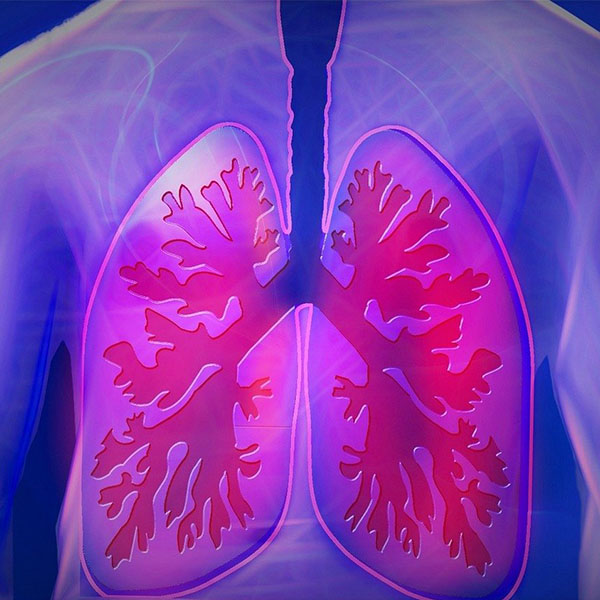
3D Illustration of human lungs (kalhh, Pixabay)

3D Illustration of human lungs (kalhh, Pixabay)
How does this align with my curriculum?
Learn about how different animals breathe, from fish to humans.
All animals need oxygen from the environment. They use oxygen to transform the nutrients they get from their food into energy. This energy is used to carry out the different functions of living, such as moving, learning, and digesting. When food combines with oxygen, energy is produced. This process is called.
During metabolism, carbon dioxide is produced as a waste product. Animals must be able to get rid of carbon dioxide for proper metabolism to happen. The respiratory system is the organ system animals use to bring in oxygen and get rid of carbon dioxide. We call the process of bringing in oxygen and releasing carbon dioxide breathing.
Mammalian Respiratory System
Breathing starts with the movement of air through your mouth and nostrils. The human respiratory system begins at the trachea. This is a stiff tube reinforced by rings of cartilage. It starts at the back of your mouth and nose and then splits into two tubes called bronchi.
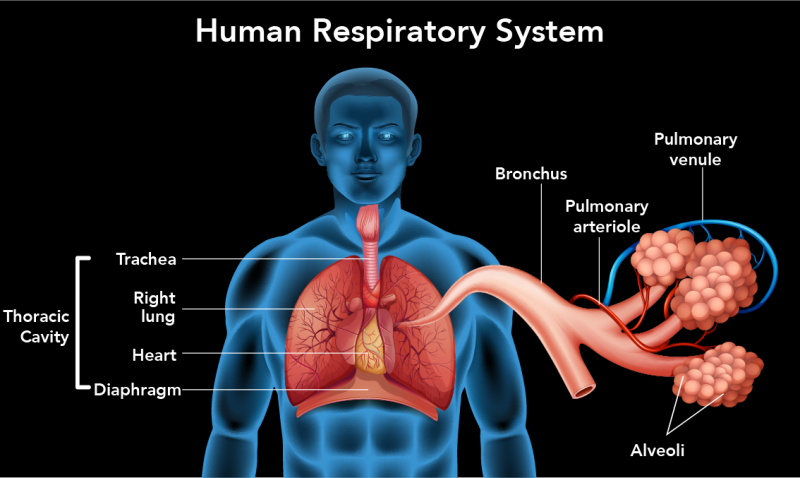
Image - Text Version
Shown is an illustration of the human respiratory system and upper part of a male human body. The parts of the respiratory system are opaque while the rest of the body is translucent.
Coming down from the mouth in the neck area is a pink tube shaped object labelled as the trachea. Branching off the bottom of the trachea are the dark pink and heavily veined lungs, one on each side of the body. The heart is also shown as a yellowish shape behind the lungs. At the base of the lungs is a curved light pink shape that is labelled as the diaphragm. The trachea, lungs, heart and diaphragm are labelled together as belonging in the thoracic cavity.
Coming off the left lung are some of the interior structures of the lung. These structures have been significantly enlarged to make them easier to identify.
Directly coming off the lung is a pink, spaghetti-like structure that is labelled as the bronchus. The bronchus splits into branches, some of which end in structures that resemble bunches of pink grapes. The grape-like objects are labelled as the alveoli. It is within these structures that gas exchange takes place.
Wrapping around the bronchi and alveoli are two other thin, branching structures. The ones coloured red are labelled as pulmonary arterioles and the ones coloured blue are labelled as pulmonary venules. These are blood vessels that transport molecules to and from the lungs.
You can feel the cartilage rings in your trachea by running your fingers down the front of your neck. Can you feel the ridges? Those ridges are the cartilage rings! Each splits off many times to form smaller tubes called bronchioles. These bronchioles form a complex network of millions of little tubes that lead to sacs called alveoli. This complex network of tubes and sacs forms the lungs.
Did you know?
Your left lung is smaller than your right lung. This is because the left lung has to leave space for your heart!
Your lungs, as well as your heart, are located in your chest, also known as your thorax. These organs are protected by a frame of bones called the rib cage. The diaphragm separates the thoracic cavity from the abdominal cavity, where the stomach and intestines are found. It is a large, dome-shaped muscle located below the rib cage.
Ventilation
Ventilation is the process by which air is pulled in and pushed out of the lungs. This is done by controlling the volume of the thoracic cavity, which is the space where the lungs are found. The main muscle responsible for ventilation is the diaphragm. It is helped by the intercostal muscles, which are muscles between our ribs.
When you breathe in, the diaphragm and intercostal muscles contract. This increases the volume of the thoracic cavity and causes air to rush into the lungs. This phase of ventilation is called inhalation.
Exhalation is when you breathe air out. During this phase, the diaphragm and intercostal muscles relax. This causes the space in the thoracic cavity to get smaller so air is forced out of the lungs.
Try taking a deep breath and imagining you are filling your lungs completely full of air. If you put your hands on your stomach, you can feel how far it moves out each time you breathe in.
The Gas Exchange Pathway
Let’s zoom in at a microscopic view and see how oxygen and carbon dioxide are transported and used in our bodies.
When an oxygen molecule is inhaled, it moves into the respiratory system through the mouth or nose. It then passes through the trachea, bronchi and bronchioles and into an alveolus. In the alveolus, the oxygen diffuses into the blood in the surrounding . Now the oxygen is in the circulatory system.
are specialized cells that carry the gases in the blood. They do this using a specialized protein called hemoglobin. Within red blood cells, hemoglobin binds with molecules of oxygen and carbon dioxide. Hemoglobin relies on an iron molecule to make this happen. That’s why it's important to always have enough iron in your diet. A deficiency in iron is called anemia. This can cause fatigue as well as other more serious health problems.
You probably know that when iron rusts it looks reddish-orange. The same happens when hemoglobin binds to oxygen molecules. This is the reason why our blood looks red.
Did you know?
Some animals use other molecules with their gas exchange proteins. Horseshoe crabs have a protein that binds with copper called hemocyanin. This makes their blood look blue. And it doesn’t end there! Some animals have purple or even transparent blood!
Misconception Alert
You might see blue veins through your skin. But the blood in our veins is not blue. This is an effect of blue light being the only one that can travel through our skin to our eyes!
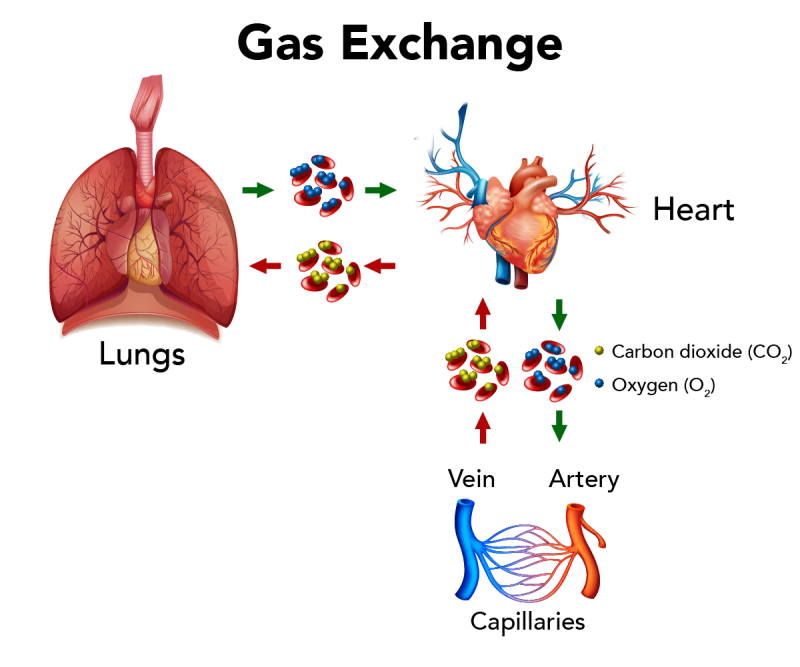
Image - Text Version
Shown is a colour illustration of the organs and cells involved in gas exchange. On the upper left is an illustration of the lungs. A green arrow on the right of the lungs points to red oval-shaped objects overlaid with small blue spheres. The ovals are red blood cells and the spheres represent oxygen molecules. From there another green arrow points to the heart. Below the heart, another green arrow points to more blood cells with oxygen. A second green arrow points to a red tube-shaped structure identified as an artery. To the left of the artery is a similar blue structure identified as a vein. Between the artery and vein are thin branching red and blue lines identified as capillaries. Above the vein is a red arrow that points to blood cells that have yellow spheres instead of blue spheres. These spheres represent carbon dioxide molecules. Above these blood cells is a red arrow pointing to the heart. To the left of the heart is a red arrow pointing to more blood cells with carbon dioxide. To the left of the blood cells is a red arrow pointing to the lungs.
The oxygenated blood is then sent from the lungs to the heart which pumps it to the rest of the body through the arteries. Arteries branch out into all parts of the body and get smaller, until they become capillaries. Here oxygen diffuses from the blood to the body cells that need it.
Diffusion is the movement of molecules from an area of high concentration to an area of low concentration. High concentration areas are where there are many of a certain type of molecule. Low concentration areas are the opposite.
Diffusion of oxygen from the blood to the body cells happens because the concentration of oxygen is higher in the blood than in the cells. Since molecules move from high to low concentration, oxygen moves from blood to cells.
Inside any body cell, oxygen is taken up by mitochondria. Some people call this the powerhouse of the cell. There's a good reason for this. In the mitochondria, oxygen and sugars are used and produce energy for bodies. A waste product of this metabolism is carbon dioxide.
Now, let's follow a carbon dioxide molecule as it leaves the body. The concentration of carbon dioxide in the blood increases as cells produce it as waste. This causes it to diffuse into the blood. The carbon dioxide is carried by the red blood cells through the veins to the lungs. The lungs have a low concentration of carbon dioxide compared to blood. This is why carbon dioxide diffuses into the alveoli of the lungs. From there it passes through bronchioles, bronchi, and the trachea to leave the body through the nose or mouth. This is the process of exhalation.
The process of absorbing oxygen and releasing carbon dioxide we call gas exchange. All animals use a gas exchange to breathe. There are some differences, though, in the organs and molecules that make it happen.
Did you know?
There is a group of tiny bottom-dwelling marine organisms that live in an environment with no oxygen. It is believed that the Loricifera do not have mitochondria, and instead have a different type of organelle that can metabolize sugar without oxygen.

Image -Text Version
A pink-stained microscope image of a tiny organism resembling a closed umbrella top connected to a shaggy head of hair.
Respiratory Systems of Non-Mammalian Animals
Birds
The lungs of birds are organized very differently than those of humans. Unlike in human lungs, where the air moves both in and out, in bird lungs, the air only flows in one direction. To help make this possible, birds have nine air sacs that surround the lungs. The air sacs allow for a continuous stream of air to flow through the lungs. It is important to note that gas exchange does not happen inside the air sacs.
For a complete respiratory cycle, birds require two inhalations and two exhalations.
- On the first inhalation air flows from the trachea to the rear air sacs.
- On the first exhalation air flows from rear air sacs to lungs.
- On the second inhalation air flows from lungs to front air sacs.
- On the second exhalation air flows from the front air sacs out through the trachea.
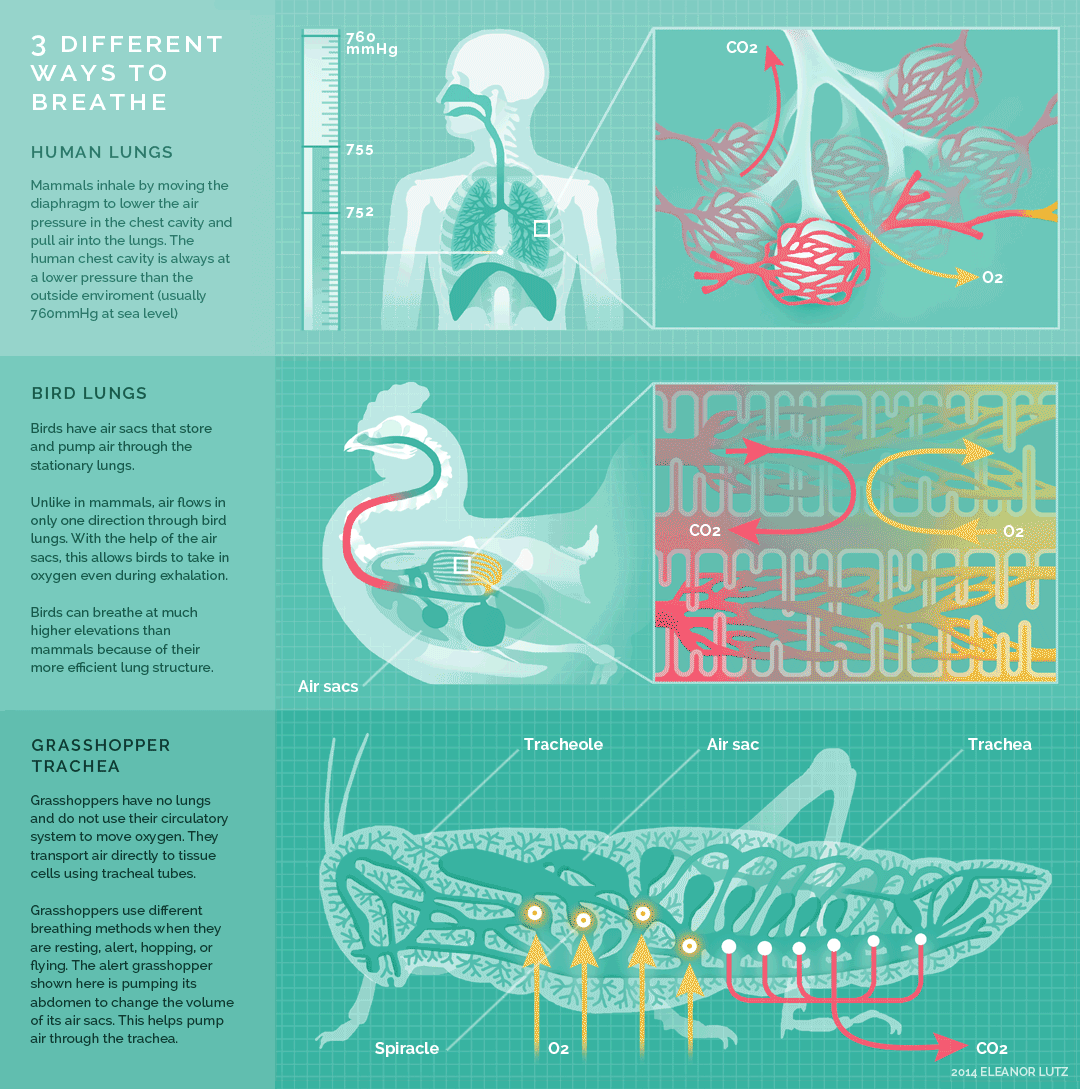
Image -Text Version
Human Lungs
Mammals inhale by moving the diaphragm to lower the air pressure in the chest cavity and pull air into the lungs. The human chest cavity is always at a lower pressure than the outside environment (usually 760mmHg at sea level).
Bird Lungs
Birds have air sacs that store and pump air through the stationary lungs.
Unlike in mammals, air flows in only one direction through bird lungs. With the help of the air sacs, this allows birds to take in oxygen even during exhalation.
Birds can breathe at much higher elevations than mammals because of their more efficient lung structure.
Grasshopper Trachea
Grasshoppers have no lung and do not use their circulatory system to move oxygen. They transport air directly to tissue cells using tracheal tubes.
Grasshoppers use different breathing methods when they are resting, alert, hopping, or flying. The alert grasshopper shown here is pumping its abdomen to change the volume of its air sacs. This helps pump air through the trachea.
The bird respiratory system is far more efficient than that of mammals. The continuous flow of oxygen is important to birds as they need a lot of energy to fly. Another advantage of the air sacs is that they make birds less heavy!
Reptiles
The respiratory system of reptiles is similar to that of humans. One major exception is that most reptiles, except for members of the crocodile family, do not have a diaphragm. They have evolved different ways to inflate their lungs.
Many reptiles and amphibians use their throat muscles to “gulp” air in a process called buccal pumping.
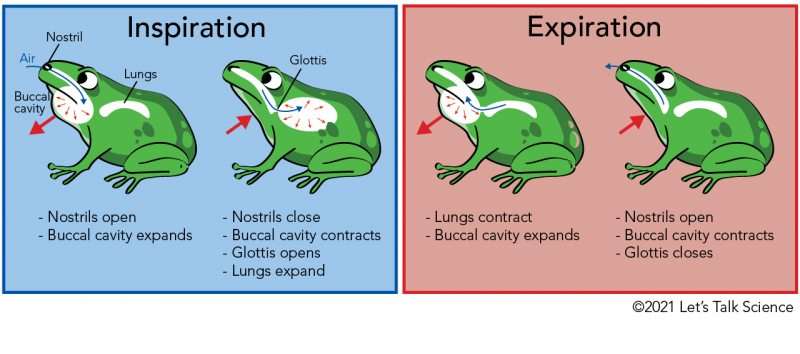
Image - Text Version
Shown is a colour illustration showing the 4-step process of inspiration and expiration in a frog.
On the left side is a blue rectangle with the title, "inspiration." In the rectangle are two drawings of frogs. The frog on the left has several body parts labelled. These include the nostrils, which are located above the mouth, the lungs, which are located in the main part of the body, and the buccal cavity which is located in the throat area. In this first stage of inspiration, a blue arrow shows how air moves from outside the frog, through the nostril and into the buccal cavity. Red arrows show that when this happens, the buccal cavity expands outwards. The frog on the right shows what happens in the next stage of inspiration. The nostril is shown as closed, a blue arrow points to air moving past a part identified as the glottis and into the lungs. One red arrow points to the buccal cavity which has contracted. Another red arrow shows that the lungs are expanding.
On the right side is a pink rectangle with the title, "expiration." Again, there are two drawings of frogs. The frog on the left illustrates what happens during the first stage of expiration. A blue arrow shows how air moves from the lungs and through the glottis. Red arrows show that when this happens, the buccal cavity expands outwards. The frog on the right shows what happens in the second stage of expiration. The nostril is shown as open, a blue arrow points to air moving out through the nostril. One red arrow points to the buccal cavity which has contracted. At this stage the lungs have contracted.
There are four steps in buccal pumping.
- First, air is let in through the nostrils. The buccal cavity, which is connected to the mouth, expands.
- When the buccal cavity is full, the nostrils close and airways to the lungs open. The opening to the airway is called the glottis. Then, the animal uses muscles to push air into the lungs.
- When exhaling, first the lungs contract which pushes air into the buccal cavity. The buccal cavity once again expands.
- Finally, the glottis closes, the buccal cavity contracts and the nostrils open.
Turtles use many different methods to breathe. Some move their legs into and out of their shells to help inflate and deflate their lungs. Others have large muscles that wrap around the lungs to control the volume of the thoracic cavity. Finally, some aquatic species can even use their cloaca to breathe. The cloaca is the external opening used for solid, liquid excretions and access to the reproductive system. In mammals, there are different openings for these things. Cloacal breathing is mostly used when turtles hibernate underwater. It is considered to be a type of respiration, which is gas exchange that happens through the skin.
Did you know?
Sea turtles can hold their breath for up to 10 hours!
Another interesting detail of most reptiles is that they lack a separation between their nose and mouth. This forces them to stop breathing to be able to swallow. To deal with the long time it takes to swallow their prey, snakes have a long extension of the trachea.
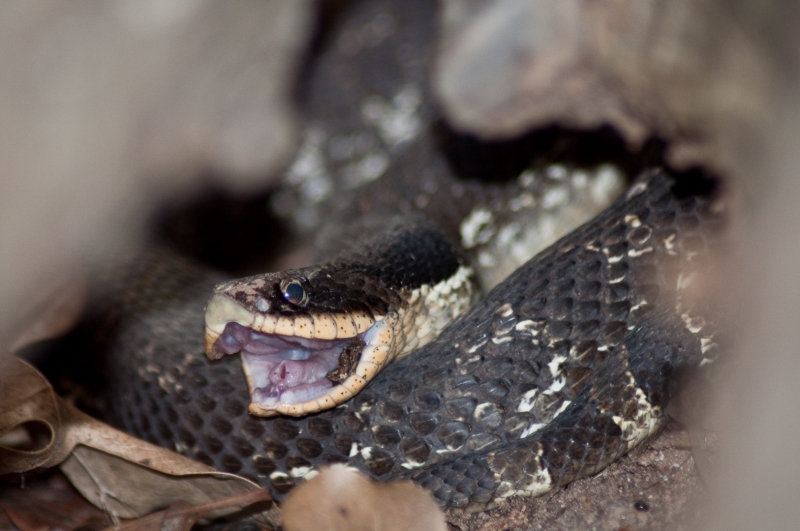
Image - Text Version
Shown is a colour photograph of a snake. The snake is dark brown with small beige patches here and there. The area around the mouth is a pale orange. Only the head and a few coils of the body are visible through some blurry leaves. The snake's mouth is wide open. Within the pale pink mouth is a pink tube-shaped structure. This is the snake's trachea.
Amphibians
Amphibians are animals that have adapted to living both on land and in water. This group includes frogs, toads, salamanders and newts. Amphibians are interesting because they start off as aquatic larvae before they move on land as adults. As they grow and move from living in water to living on land, their respiratory systems change.
In their juvenile forms, amphibians have gills that let them breathe underwater, just like fish. As they grow to their adult form, the gills disappear and lungs develop to replace them. Some species of salamanders remain aquatic, however, and keep their gills all through their lives. We call keeping characteristics of the larval stage neoteny.
Neoteny is easily seen in axolotl (pronounced axe-o-lot-ill), a popular aquarium species from Mexico. In Canada, our largest salamander species is the mudpuppy. It is easy to recognize because it has reddish gills on each side of its head.

Image - Text Version
Shown is a colour photograph of a mudpuppy. Only the head, front right leg and a small portion of the body is visible. The mudpuppy is mainly a purplish-grey colour. It also has golden splotches all over its body. It has a wide, flat head with small gold and black eyes. Just behind the head are projections, similar to ears, that have dark red feathery edges. These are their gills.
In addition to buccal pumping, amphibians also use . This means that the gas exchange happens through the animal’s skin. Many other animals have cutaneous gas exchange, even humans, but in small quantities! Amphibians rely on this process much more. The lungless salamander, as its name implies, almost exclusively uses its skin to breathe. This breathing method requires having thin skin that can be kept wet, which many amphibians have. Since their breathing happens through their skin, it is best not to handle amphibians. Not only can you affect their breathing, you can also transfer germs from your skin to theirs.
Fish
The respiratory system in fish is very different from the respiratory systems ofanimals. Like frog larvae and mudpuppies, fish have gills. Gills are similar to lungs in that they have branches that split. Gill arches branch to form gill filaments. On the gill filaments are gill lamellae, which is where gas exchange occurs. Here oxygen dissolved in water diffuses into the blood and carbon dioxide diffuses into the water.
In , a bony plate called an operculum covers and protects the fragile gills. In cartilaginous fishes, such as sharks and rays, the gills are located near their 5 to 7 gill slits.
During the inhalation phase, fish pull water in through their oral valve to their buccal cavity. From there the water is pushed towards their gills. The opercular valve is closed at this point. During the exhalation phase, the oral valve is closed and the opercular valve is opened. Water passes over the gills and out through the opercular valve.
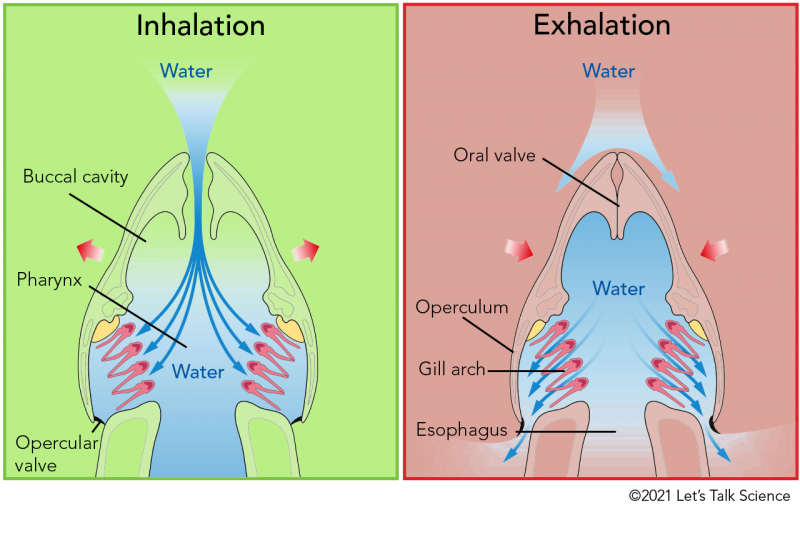
Image - Text Version
Shown is a colour illustration of the processes involved in fish inhalation and exhalation.
On the left side is a pale green rectangle with the title, "Inhalation." Below it is a cutaway view of a fish's head. At the top end is the mouth. It is fairly pointed and has a narrow opening which connects with the larger buccal cavity. Pink arrows on either side of the head indicate that the fish is pushing its gills outwards. When this happens, blue arrows indicate that water comes in through the oral valve and into the buccal cavity and then on to the pharynx at the back of the head. The water then heads towards the gill arches, which are light pink two-pronged structures. Beyond the gill arches is an opening with a small flap in the closed position. This is the opercular valve. Some water also passes into the fish's esophagus at the back of the head.
On the right side is a pink rectangle with the title, "Exhalation." Below it the same cutaway view of a fish's head as in the previous image. Pink arrows on either side of the head indicate that the fish is pulling its gills inwards. At this point the oral value at the mouth is closed. Blue arrows indicate that some water bypasses the fish's head. Other blue arrows within the pharynx area indicate that the water is passing over the fill arches. Some of the water is also passing through the now open opercular valve and out to surrounding water. Most water does not pass into the esophagus at this stage.
Some fish have specialized muscles that allow them to pump the water over their gills. Fish that are very active use a type of ventilation called ram ventilation. Moving forward forces water to move over the gill arches so that oxygen and carbon dioxide can be exchanged. Sharks are a type of fish that use ram ventilation. This is why some species of sharks can actually drown if they stop moving!
Did you know?
Sharks and rays bring water into their buccal cavities through an extra opening behind the eye called a spiracle. Spiracles are also used by insects for respiration.
Learn More
Respiratory System | The Dr. Binocs Show (2016)
This animated video (3:52 min.) by Peekaboo Kidz presents many fascinating facts on the respiratory system.
Respiration 3D Medical Animation (2011)
This animation (1:43 min.) by Dr Ian Lahart shows in detail how respiration happens in the human body.
Circulatory & Respiratory Systems
This video (11:39 min.) from CrashCourse Biology presents how animals breathe.
The many colors of blood
This document from the American Chemical Society presents a classroom lesson and backgrounder on the different types of blood in the animal kingdom.
Your Lungs & Respiratory System
This section of the KidsHealth website describes our lungs and respiratory system.
References
Buccal Pumping (2020). Wikipedia, retrieved from https://en.wikipedia.org/wiki/Buccal_pumping
Feder, M.E. and W.W. Burggren (November 1985). Skin Breathing in Vertebrates. Scientific American: 126-142.
Mammalian Systems (n.d.) Biology For Majors II. Lumen Learning, retrieved from https://courses.lumenlearning.com/wm-biology2/chapter/mammalian-systems/
Reptile Structure and Function: Advanced (2016). CK-12, retrieved from https://www.ck12.org/book/ck-12-biology-advanced-concepts/section/16.21/
Systems of Gas Exchange (n.d.) Boundless Biology. Lumen Learning, retrieved from https://courses.lumenlearning.com/boundless-biology/chapter/systems-of-gas-exchange/
Tattersall, G.J. (2007). Skin Breathing in Amphibians. Endothelial Biomedicine: A Comprehensive Reference: 85-91